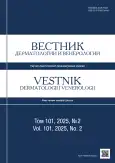А choice of therapy for severe forms of alopecia area
- 作者: Gallyamova Y.A.1
-
隶属关系:
- Russian Medical Academy of Continuous Professional Education
- 期: 卷 101, 编号 2 (2025)
- 页面: 94-99
- 栏目: CLINICAL CASE REPORTS
- URL: https://bakhtiniada.ru/0042-4609/article/view/310162
- DOI: https://doi.org/10.25208/vdv16790
- ID: 310162
如何引用文章
全文:
详细
Alopecia areata is a chronic organ-specific autoimmune inflammatory disease with a genetic predisposition. Alopecia areata is characterized by damage to hair follicles, persistent or temporary non-scarring hair loss. A treatment of severe form of alopecia areata is a difficult task. Systemic glucocorticoids are indicated in the severe form of alopecia areata, which undoubtedly have side effects with a negative influence on health. The main idea of the article demonstrates clinical examples of the therapy for such patients, which based on the clinical experience. Modern medicine offers a new approach to the treatment of severe forms of alopecia areata, which bases on blocking Janus kinase (JAK). JAK converts and activates the transcription pathway in the pathogenesis of the disease. Currently, FDA (US Food and Drug Administration) has approved two Janus kinase inhibitors: baricitinib and ritlecitinib. Tofacitinib is a representative pan-JAK inhibitor that blocks JAK1/3 but inhibits JAK2 weakly. Tofacitinib hasn’t been approved for alopecia areata by FDA yet. The article demonstrates high effectiveness tofacitinibe of the therapy severe forms of alopecia areata: total and universal and also the safety of treatment.
作者简介
Yulia Gallyamova
Russian Medical Academy of Continuous Professional Education
编辑信件的主要联系方式.
Email: 89161704546@mail.ru
ORCID iD: 0000-0002-1674-3007
SPIN 代码: 5601-1201
MD, Dr. Sci. (Med.), Professor
俄罗斯联邦, Moscow参考
- Rice JB, White AG, Scarpati LM, Wan G, Nelson WW. Long-term Systemic Corticosteroid Exposure: A Systematic Literature Review. Clin Ther. 2017;39(11):2216–2229. doi: 10.1016/j.clinthera.2017.09.011
- Volmer T, Effenberger T, Trautner C, Buhl R. Consequences of long-term oral corticosteroid therapy and its side-effects in severe asthma in adults: a focused review of the impact data in the literature. Eur Respir J. 2018;52(4):1800703. doi: 10.1183/13993003.00703-2018
- Van Moortel L, Gavaert K, De Bossecher R. Improved Glucocorticoid Receptor Ligands: Fantastic Beasts, but How to find them? Front Endocrinol (Lausanne). 2020;11:559673. doi: 10.3389/fendo.2020.559673
- Lensing M, Jabbari A. An overview of JAK/STAT pathways and JAK inhibition in alopecia areata. Front Immunol. 2022;13:955035. doi: 10.3389/fimmu.2022.955035
- Bilgin E, Ceylan F, Duran E, Farisoğullari B, Bölek EÇ, Yardimci GK, et al. Efficacy, retention, and safety of tofacitinib in real-life: Hur-bio monocentric experience. Turk J Med Sci. 2021;51(1):297–308. doi: 10.3906/sag-2007-123
- Sandborn WJ, Lawendy N, Danese S, Su C, Loftus EV Jr, Hart A, et al. Safety and efficacy of tofacitinib for treatment of ulcerative colitis: final analysis of OCTAVE Open, an open-label, long-term extension study with up to 7.0 years of treatment. Aliment Pharmacol Ther. 2022;55(4):464–478. doi: 10.1111/apt.16712
补充文件










